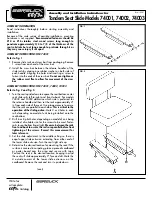
Product Description
20 / 96
EN
· 30.30.01.02851 · 01 · 03/22
Compressed air connection
The compressed air is connected via a ¼" plug-in screw union for a compressed air hose with an outside diameter of
12 mm for FXP-i and 8 mm for FMP-i. Use a PU hose to connect the compressed air. We recommend using
compressed air supply lines with the max. possible internal diameter whenever possible. If a hose with an insufficient
internal diameter is used on the compressed air side, the ejector/valve will not receive enough compressed air to
operate at optimal capacity. For grippers FXP-i that are longer than 838 mm, a compressed air connection is provided
on both end covers because two vacuum generators are used here.
Compressed air connection for separation (optional)
The 1/8" connection (4) for the optional separation pulse is located in the end cover. When the product is delivered,
the end cover is closed with a plug.
The compressed air connection (4) for separation should only be connected on the side with the markings (6) of the
sliding block strip. The markings are on either end of the section. The amount of compressed air can be set to the
customer’s requirements using the valve screw.
The separation pulse is needed when two or more air-permeable sheets are picked up during suction. The briefly
applied compressed air pulse separates the second sheet from the first. The valve screw setting can vary according to
the properties of the workpieces.
The separation function can only be connected if there is a marking hole at the end of the section! If you
wish to retrofit this function, please contact Schmalz to obtain the conversion measures.
Electrical connection
The electrical connection is designed as a 6-pin M8 connector. It supplies the gripper with voltage and communicates
with the controller.
3.4.5
Silencer on Grippers FXP-i
NOTE
Closing the exhaust air outlet (1)
Increase in the internal pressure in the ejector
The exhaust air outlet on the silencer housing must not be closed. If the exhaust air outlet is closed, the
internal pressure in the ejector and in the valves will continue to rise until it exceeds the maximum
permitted operating pressure. This can result in damage to the ejector and/or injuries.
The silencer housing is lined with sound-dampening material and serves to reduce the exhaust noise. For cleaning,
the housing can be quickly unscrewed and the dampening material can be cleaned with compressed air.
1
















































